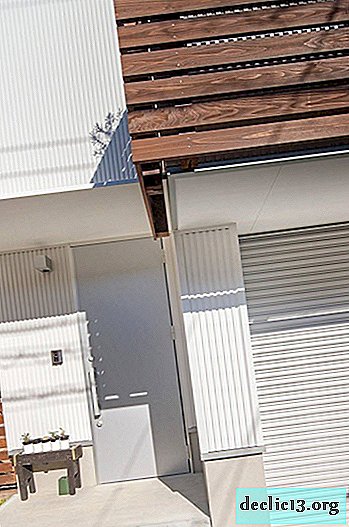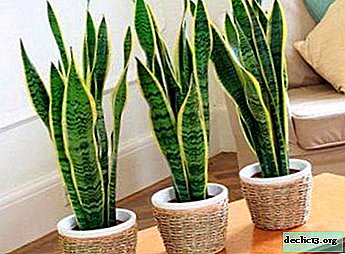How to organize the right care for prickly pear? Features of growing cactus at home and outdoors

Prickly pear - a unique representative of cacti, capable of growing both at home and in the open ground. The unusual appearance and the absence of difficulties in care allows the prickly pear to remain the favorite of gardeners from year to year.
Prickly pears are upright or creeping shrubs, less often trees with flat juicy articulated stems on which areoles are located, depending on the species, containing large or small spines and bundles of easily breaking off thin, fragile, hook-like bristles - glochidia, which very painfully penetrate the skin. The leaves are small, juicy, awl-shaped, early falling. The flowers are single, bisexual, bright red, orange or yellow. The fruit is an edible berry. Seeds are flat with a hard peel.
How to care at home?
Temperature
In the summer, prickly pears feel comfortable at a temperature of 25-35 degrees. In autumn, the temperature begins to gradually decrease to provide the plant with a dormant period.In autumn, the conditions for keeping the cactus depend on the homeland of the species.:
- For species native to the western and central regions of the United States from -5 to +5. Certain species can be kept in the open ground, they perfectly tolerate wintering in the snow.
- For Mexican species, the optimum temperature is from 0 to 5 degrees.
- For South American from 7 to 12 degrees.
The types of prickly pear are described in more detail here.
If you do not observe the temperature regime during dormancy, prickly pear will stretch.
Watering
 In the spring-summer period, the cactus requires plenty of watering, but it should be monitored so that in the interval between them the earthen lump completely dries out. Watering is carried out in such a way so as not to fall on the stems of the plant, from this the pores are clogged by lime formations and breathing is disturbed.
In the spring-summer period, the cactus requires plenty of watering, but it should be monitored so that in the interval between them the earthen lump completely dries out. Watering is carried out in such a way so as not to fall on the stems of the plant, from this the pores are clogged by lime formations and breathing is disturbed.
Several nuances of prickly pear watering:
- If there is intense heat, watering is reduced and carried out only after five in the evening, as during the day the life processes of the cactus slow down.
- In dormancy (autumn and winter), cacti do not water, with the exception of young plants.
- When the growing season begins, the first watering should be carried out with caution and a small amount of water.
- Water for irrigation should be well settled, it is advisable to add citric acid into it at the rate of half a teaspoon per seven liters of water.
Shine
With room contents of prickly pears, it is necessary to provide bright lighting and a regular flow of fresh air.To make the plant feel comfortable, you should adhere to the following recommendations:
- Do not allow shading.
- Opuntia feels best with open keeping on the south and southeast windows and balconies.
- If there were few clear days in the autumn-winter period, in spring, exposing the plant to open air, you should accustom it to the sun's rays gradually, in order to avoid burns.
- During the flowering of prickly pears, you can not change its location relative to the cardinal points, the plant can throw off flowers.
Lack of light leads to deformation of the plant, it stretches, loses its decorative properties and does not bloom.
Priming
 If you don’t feel like burdening yourself with the preparation of the substrate, You can buy a ready-made mixture for cacti and succulents in a flower shop, if the idea of self-preparation of the soil is enthusiastic, there are two options:
If you don’t feel like burdening yourself with the preparation of the substrate, You can buy a ready-made mixture for cacti and succulents in a flower shop, if the idea of self-preparation of the soil is enthusiastic, there are two options:
- For planting by the cuttings, a drainage layer is laid on the bottom of the dishes, and calcined sand and charcoal are poured on top.
- When planting seeds, drainage is also required, and then a mixture of calcined sand, charcoal and compost is poured. Proportion 1: 1: 2.
Pruning
Given the high ability of prickly pears to vegetate, it is very often a plant, reaching a growth of more than a meter, begins to deform. To deal with this, you will need to conduct the formation according to the following scheme:
- Cut long trunks with a disinfected sharp scalpel, leaving only short erect.
- The remaining "hemp" will actively act as a mother liquor to receive new "children."
Top dressing
During the growing season, the plant is fed once a month with special fertilizer for cacti and succulents.
Pot
Almost any flower pots are suitable for planting prickly pears, the main factor when choosing is the presence of drainage holes at the bottom. The size of the pot can regulate the growth of the cactus, giving freedom for its roots to grow or vice versa.
Transfer
You can determine the best time for transplantation by visually assessing the condition of the plant. If it has grown, it is possible to transplant, but if there are buds on the prickly pear, the transplant is carried out only after flowering.Young plants are transplanted annually, this stimulates active vegetation, adults once every 3-4 years.
For transplantation it is necessary:
- Stop watering a week before the procedure, so that the earthen lump is completely dry.
- Prepare a new tank.
- Tap lightly on the walls of the old pot so that the lump of soil along with the roots moves away from them.
- Remove the cactus with a glove or sandwiched between two kitchen sponges.
- You can not compress the plant strongly so as not to damage it.
- The roots should be carefully examined. If they are healthy, then the earthen lump is crushed and the old soil is shaken, if damaged, cut off all affected areas with a scalpel and dust the cuts with coal dust. Allow to dry and only then move on.
- At the bottom of the new tank lay drainage and some soil.
- Install the cactus, carefully fill up the rest of the soil so that part of the root neck is hidden. Tamping the soil is not necessary.
- Lay a layer of fine gravel drainage on top.
We offer to watch a video about prickly pear transplantation:
Photo
We offer you to familiarize yourself with the photo of prickly pear.





How to care after purchase?
Having brought the prickly pear from the store, it is necessary for two weeks to leave it in quarantine, separate from other plants, in order to prevent possible infection by pests that were not immediately detected.If the plant was not acquired in winter, then after purchase it is recommended to transplant it immediately by transshipment without violating the earthen lump.
Wintering
- To transfer prickly pear prickly pears, watering is gradually reduced from autumn to fall, and temperature is also gradually reduced.
- If watering is reduced and the temperature is left unchanged, the plant will continue to evaporate moisture, but will not receive fluids in return, this will lead to irreversible health effects of the cactus.
- To ensure a cool wintering, you can build a plexiglass fence for prickly pear so that the heat from the heating radiator does not touch it.
- To control the temperature you need to purchase a thermometer, control watering using a calendar.
- Watering in the winter is reduced to a slight moistening of the earth, literally one teaspoon of water, away from the root neck.
Features of growing cactus in open ground
Being on a flower bed, prickly pear can tolerate infrequent frosts down to -10 degrees. In summer, it looks great in the composition of the alpine slides. For the landing of prickly pears, an open, well-lit area without drafts is suitable. It is necessary to organize drainage, since in winter the plant will die quickly from excess moisture.
For the first time leaving a cactus to winter in the open air, it will be necessary to cover it with dead wood and needles. During the winter, the plant is deformed, but with the advent of spring it will be reborn.
By summer, a stronger prickly pear prickly pear will pick up buds. Also in the summer, once every two weeks, special feeding for cacti should be applied.Diseases and Pests
| Disease | Cause | How to treat |
| Anthracnose (brown spotting) | Fungal infection, manifested in the form of moist yellow-brown patches on the plant | The affected areas are removed with a sharp knife, a fresh wound is sprinkled with sulfur, and the whole plant is treated with fungicides. |
| Rot | Disease caused by improper care: insufficient lighting and excessive watering | If the rot has not yet hit the entire body of the cactus, the diseased areas are cut and sprinkled with sulfur. If the root system is partially affected by rot, all diseased roots are also trimmed and sprinkled with charcoal powder. Watering plants resume no earlier than three weeks. |
| Mealybug | Appears when the temperature is too hot and the importance of air | Infected plants can be detected by spraying with infusion of garlic, tobacco or a solution of green soap. Before processing insects must be removed manually. |
We offer you to watch a video about diseases and pests of Opuntia:
Breeding
 Opuntia propagated by seeds and cuttings:
Opuntia propagated by seeds and cuttings:
- Cactus seeds have a hard crust, so before planting in the soil they are soaked in a solution of manganese (and about the use of oil from prickly pears see here). Crops contain at a temperature of 20 degrees, the container should be covered with a film, which must be removed periodically for ventilation and spraying.
- When propagated by cuttings, the shoots are cut from the main shoot and dried for three days, then planted in previously calcined sand.
To root, the pot is covered with a jar and the temperature is maintained at 22 degrees.
Planting periodically open for ventilation and soil moisture. After rooting and the appearance of new buds, they are transplanted into ordinary soil.
We offer you to watch a video about the reproduction of prickly pear:
Conclusion
Prickly pear - a vivid representative of a kind. A flat body, unusual thorns and bright flowering give this plant the opportunity to be chosen as a unique highlight of the interior or an interesting resident of a well-kept garden.

















